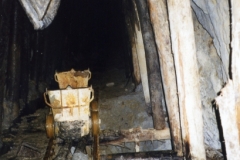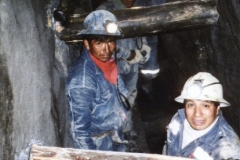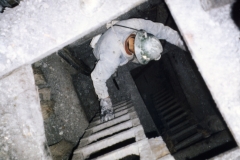Going deep into South America
South America is a major producer of the World’s Metals. Chile is renowned for the abundance of copper, providing one third of the world’s supply. Peru is the leading nation in the production of silver and zinc, and also produces significant amounts of copper, lead, and gold. Bolivia retains the record of having the world’s largest silver mine at Potosi, but it has many other mining camps that mined silver, including the modern operation of San Cristobal. Bolivia was also for many decades the world’s leader in the production of tin. Brazil is a major miner of iron and gold. Colombia and Venezuela are more known for gold mining. In southern Argentina, in Patagonia, are numerous significant gold and silver veins with active mining today. It is fair to say that just about every household in the world uses metals that have been mined in South America. An ongoing question under investigation is where are the deepest underground mines in South America?
What is deep? For reference, South African gold mines are the deepest in the world, with the Mponeng mine reaching 4 km below surface being the deepest. Below the depth of 600 meters (this varies by rock type and other conditions) rock bursts, exploding mine walls from the overlying pressure of the rock mass, become very real and life threatening danger. Because of the Earth’s geothermal gradient, deep mines have hot working conditions. The depth of mining is depends of economics, the value of the ore, and the cost of extraction. A major cost that limits many mines is the pumping of water from the mine. In this context, it makes sense the most valuable ores, gold, develop the deepest mines. Searching for information on deep mining typically yields data on relatively shallow modern mines, after all, historic mines from companies no longer in existence do not maintain webpages. So the list presented below is preliminary and may require updates. Please send in any information on deeper underground mines if you have supporting credible citations.
Argentina: The active El Aguilar zinc mine, in the Jujuy Province, is presently operated by Glencore. It is Argentina’s oldest active mine having 80 years of exploitation in which it has mined down to 600 meters below surface.
Bolivia: the Pulacayo silver vein, one of the richest single veins in existence in Bolivia, with more than 500 million ounces of silver being mined. It had four production shafts, the deepest of which was 900 meters. The vein was mined too down, to the 1000 meter depth. The lower workings of the mine are presently flooded, the upper portion of the mine is active at a very small scale through near artisanal mining by a local cooperative. Many of the country’s tin camps had very deep cassiterite veins; some of these may be contenders for the deepest mines in Bolivia. These include the districts of Chorolque, Colquiri (mined to 500 m depth), Colquechaca, Chacaltaya (~500 meters mined depth), Huanuni (mined to the 700 m depth), Llallagua (San Fermin vein mined down to 775 meters in 1931), and Tasna. At Potosi, the world’s largest silver deposit, are steeply dipping veins that were mined to depths of 800 to 1000 meters below surface. Cerro Rico has a vertical relief of 650 meters, thus horizontal adits from near the base of the mountain quickly attain great depths beneath the surface.
Brazil: The deepest mine in South America is Brazil’s Morro Velho gold mine, which is currently operated by AngloGold Ashanti Brasil Mineração, in the state of Minas Gerais. In this complex the Mina Grande workings reached a depth of 2,453 meters in 1997 and then it was closed.
Chile: The world’s largest underground mine in terms of volume excavated is El Teniente copper mine operated by Codelco. In 2017 the operation is supposed to start mining from a newly developed deeper level to the block cave operation, going down to the elevation of 1880 m above sea level, or about 640 meters below surface (mine is in a deep canyon with surface elevations in the outline of the deposit varying from 2400 to 2900 meters above sea level, meaning parts of the operation are up to 1,020 meters below the surface). To the north of Copiapo, the historic and long closed underground copper vein mine of Mina Dulcinea de Llampos reached a depth of 1,156 meters.
Peru: The country has many historic mining camps, such as Cerro de Pasco, Morococha, Orcopampa, Quiruvilca, Casapalca, and Castrovirreyna, giving Peru potential for very deep mines. The Yauricocha copper mine in central Peru has mined down 870 meters underground. The currently operating El Porvenir polymetallic mine, owned by Milpo, has the deepest working shaft in South America with a depth of 1,200 meters. Base-metal and silver mines are less likely to reach similar depths of gold mines. The deepest base-metal mine in the world is Kid Creek, Ontario, Canada at 2.9 km, making it the 8th deepest mine in the world.
Many of the above listed depths were found in 50 to 80 year old geology reports that 1) have not been confirmed or are singular statements about the mine, 2) these estimates may not be accurate to conditions in the mine, and 3) additional mining could have deepened the excavations after the reports were made. A comprehensive review of all mines was not made, only the larger camps. It is possible other historic deep mines are present in each of the countries. Nonetheless, it is clear that in South America the deepest mine is in Brazil. The above listing of deep mines by country supports that gold is what drives going deep into South America.
Do connect with us:
ResearchGate: James M. Wise
Author´s page: James M. Wise
Photography page: JamesM.Wise.com
Author´s page: Yanira K. Wise
Exploring South America’s inexhaustible creative force.







